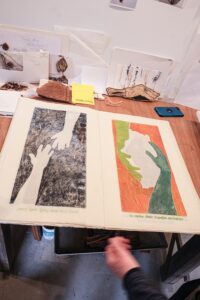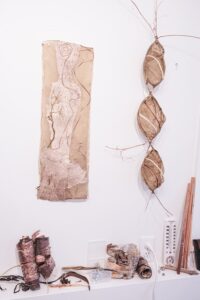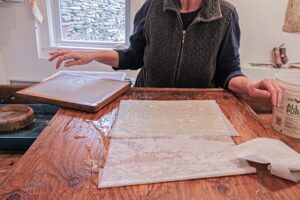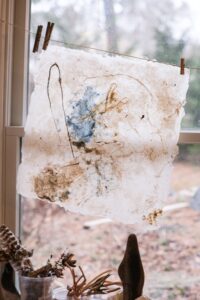
Sheryl Jaffe’s studio in her Wellfleet home feels equal parts science laboratory, industrial workshop, and cabinet of curiosities. Objects that she has collected on walks line the shelves and ledges: a bird’s nest, seaweed, rings of birch bark. On her desk are small sculptures made with dried banana leaves from her hardy tree. In the sink near her papermaking station, coils of wisteria soak in buckets of water to soften their fibers. Across the studio, she opens her refrigerator to reveal stacked jars of pulp and dyes.
Jaffe’s studio is a reflection of her exploratory and expansive art practice. She has worked in sculpture, land art, photography, installation, ceramics, papermaking, and printmaking. The throughlines are her fascination with the natural world and a deep curiosity about materials.
She grew up in Bensonhurst. “I used to go to the Brooklyn Museum every chance I got,” Jaffe says. The museum exposed her to ceramics, the medium she devoted herself to after dropping out of SUNY Purchase. “I quit to make pots at a pottery studio in Port Chester,” she says.

Soon after, she hitchhiked to Wellfleet with her friend Marla Rice, now the owner of the Rice Polak Gallery in Provincetown, and they ended up staying. Jaffe left in 1984, after eight years, to finish her degree at UMass Amherst’s University Without Walls and become an art teacher. She returned to the Cape in 2018 after retiring.
“You see people growing older and think about what’s really important,” says Jaffe. Wellfleet had the things she desired: friends nearby and ample opportunity for walking and spending time in nature.
Sidebar: Jaffe was present at my birth at home in Wellfleet in 1981. As a friend of my mother, she was there for moral support. I remember a trip with my mother and sister to visit her in Western Massachusetts where she was living with her son. It was a brief stay, but the creative atmosphere she threaded through her life left an impression on me: her raku studio in a barn, a nude ceramic sculpture, eating pesto made with basil from her garden.

In her Wellfleet studio, she opens an oversize book, The Exchange, that she created with monotypes of collagraphs on handmade paper. “It’s almost like a blanket in its softness,” she says, encouraging me to touch the paper. She made the paper from mulberry bark — a process she learned after receiving a grant to study papermaking in Japan.
The book is about her own birth story. At its center is an image of two hands encircling a white form. Below it are the words “to make their hopeful exchange.” The hands suggest caring — or is it a gesture of release? The form at the center is pure and passive.
Jaffe was born in California in 1954 to a young waitress. “She had an affair with a truck driver,” says Jaffe. “When she told him she was pregnant, he disappeared.” Someone connected her birth mother to a couple in New York who were hoping to adopt (the details remain mysterious to Jaffe). There was no adoption agency involved. Jaffe’s mother had to bring the baby to New York. “They handed me over in a ladies’ room at JFK airport,” says Jaffe.

At age 25, Jaffe found her birth mother, who had moved to Alaska and started a family. “I grew up Jewish in Brooklyn, and we started going to Alaska for Christmas when my son was four years old,” she says.
The shape at the center of The Exchange is repeated throughout Jaffe’s artwork. It’s expansive in its associations: it could be a seed, a pod, a vessel, an empty shell, a womb. On her studio wall, three of these shapes, created from paper, hang vertically like DNA strands connected by vines. On other walls, the shape reverberates in a sculpture of a large green leaf and in hanging objects that look like hammocks or cocoons.

Interconnectedness is a central theme in Jaffe’s work. Just as she transmutes a form to suggest birth, metamorphosis, death, and regeneration, she uses the act of making paper as another sort of transformation. She takes out a lump of pulp — in this case a mixture of linen and mulberry. She has beaten it literally to a pulp so that it looks like a wet mound of wool. Dispersed in a vat of water, the fibers float until they’re lifted by a screen called a mould and deckle. Turned upside down on drying mats, the mould and deckle leaves behind a gorgeous sheet of paper: wet and glistening, transparent and durable. “It’s the same magic as working in a dark room and seeing an image develop,” says Jaffe.
In this sheet of paper, various strands of fiber are visible. The singularity of these errant fibers is notable, but they float in a larger tapestry. Each fiber is a piece of the whole. Holding up a banana leaf, Jaffe comments on our connection to these plants.

“We share 71 percent of our DNA with bananas,” she says. “We’re deeply related and need the same things.”
Whether it’s a banana or a strand of pulp, a birth or the moon, Jaffe weaves together images and materials that reflect on the unity of living things in a tapestry rich with wonder and pregnant with potential, not unlike a blank sheet of paper.
“The paper is this blank, empty thing,” she says. “Anything could be put on it.”



